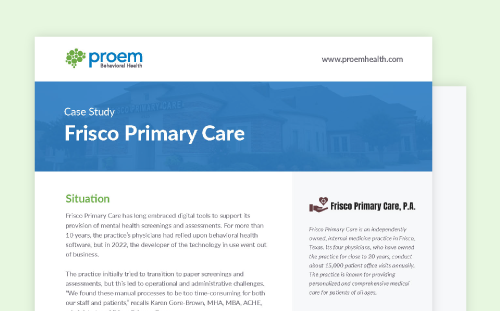
Integrated care initiatives provide an opportunity to strengthen the delivery of physical and behavioral health treatments through primary care and other health services. Providing mental health services in primary care can be effective for patients, reduce the stigma of mental illness, and strengthen provider-patient collaboration and engagement. This is crucial since 1 in 5 adults in the United States has been diagnosed with a mental disorder, and it's common for both adults and children to have more than one mental illness.
One specific type of integrated care that is often hailed as an effective approach to supporting those with mental illness is collaborative care. In this article, we explain the collaborative care model, why collaboration is important, how the approach can help in mental health treatment, and measurements of mental health often used when putting the model in practice.
What Is a Collaborative Care Model?
A collaborative care model treats mental illness by integrating physical health care and psychological treatment in a familiar setting (e.g., primary care office). This model can help address the wide gap in mental health treatment attributed to a shortage of professionals, the stigma of seeking therapy, and financial constraints. The collaborative care model also takes mental health therapy directly to patients where it's often needed most.
Why Is Collaboration Important in Healthcare?
Interprofessional cooperation entails medical and health care experts treating patients together. The benefits of collaborative care include the following:
Enhanced teamwork. Interprofessional teamwork replaces the doctor as the "quarterback" of treating patients. Nurses, radiologists, psychiatrists, EMTs, social workers and other experts from various disciplines are authorized to offer recommendations for patient care.
Better communication. Collaboration among medical and health care professions fosters better communication. Before interprofessional cooperation, each care provider would receive most of their background information from reviewing a patient's chart to learn about treatments and history. Working alone may cause errors in diagnosing symptoms or meeting patient demands and can increase the likelihood of a health care professional overlooking information important to most effectively helping patients.
More comprehensive care. When diverse professionals work together, a broader perspective on patient care emerges. Consider each medical practitioner as a jigsaw piece. Putting them all together (i.e., assembling the puzzle) helps with comprehending the patient's needs and wants.
Reduced readmissions. Clinical outcomes improve with enhanced treatment and communication, which is particularly important because misdiagnosis is common and costly in behavioral health care. In an inpatient setting, for example, misdiagnosed patients are likely to be readmitted to the hospital, causing financial and operational burdens for the medical establishment. Collaboration also helps health care providers to treat mental conditions and prevent relapse successfully.
Enhanced patient-care quality. Interprofessional collaboration enhances the ongoing effort of medical and healthcare professionals to deliver the best possible treatment to patients. Instead of the treatment team taking turns caring for patients, they collaborate in hopes of offering lasting care from the start.
Increased payment incentive. The CMS collaborative care model recognizes the benefits of integrated services. In recent years, the Centers for Medicare & Medicaid Services has updated Medicare Physician Fee Schedule (MPFS) policies to improve payment for care management services and has expanded the suite of codes covering Collaborative Care Management services.
What Is Collaborative Care in Mental Health?
Collaborative care in mental health is a method that aims to improve the correlation between mental disorders, cardiovascular disease, lung problems, immunological function and physical pain. Physical conditions may induce or intensify psychological anguish or sickness through mechanisms such as inflammation. Treating mental diseases in primary care can increase recovery rates and help lower stigma.
Here are five examples of collaborative care in mental health:
- Personalized care — Incorporating patient objectives into shared care plans helps more effectively deliver primary care and behavioral health treatment. Patient participation improves the patient experience and results.
- Population-based care — In this method, the care team works together on a specific set of patients documented in a registry. Mental health experts give caseload-focused consulting, not simply ad hoc assistance.
- Measurement-based therapy — Each patient's care plan includes personal objectives and clinical results that health care professionals regularly assess. If patients don't progress as predicted, treatments are adjusted to help meet the clinical goals.
- Evidence-based care — Patients work with therapies that data show is effective in addressing the target ailment. The collaborative care model for mental health is among the few integrated treatment models with considerable evidence of success.
- Accountable care — Through this model, providers are held responsible and compensated for clinical results, not simply patient volume.
What Measurements of Mental Health Best Support the Collaborative Care Model?
There's no one-size-fits-all approach to behavioral health measurement. However, many clinicians pursuing a collaborative care model find benefit to incorporating questionnaires and rating scales into care plans to help screen, assess, and monitor for mental health. Benefits to these instruments are that they can provide objective, comparable data over time, across care settings and among patient populations. The primary care physician, psychologist and school social worker, for example, can have a common basis for understanding and communicating progress.
Researchers looking to identify evidence-based practices for treatment or identifying correlations with data such as demographics or prescription medication information can also use the measurement data to examine trends across patient populations. Resulting guidance can inform broader healthcare best practices and is often used to inform performance-based payment.
How Proem Supports the Collaborative Care Model
Healthcare practitioners can use Proem's behavioral health solutions to electronically screen, interview, and assess and measure results for the most commonly diagnosed adult and pediatric DSM-5 mental disorders. When incorporated into the collaborative care model, providers, managers, psychiatrists, therapists and other health care and non-health care professionals can work more effectively together and help provide better personalized assessments and treatments to patients over time. This effectively reduces the treatment costs associated with mental health illnesses and supports efforts around implementing more appropriate payment structures. Visit proemhealth.com for more information.





.png)









